Given time, even the smallest garden can land you with a mountain of things to store – be they pot plants and tools or outdoor furniture. A shed usually provides the answer, but there's plenty to think about before making a choice.
Whatever size garden you have, you are sure to need some form of outdoor storage for garden equipment, tools, outdoor furniture, and other outdoor and DIY accoutrements. Before deciding on the type of storage facilities to install however, it is important to evaluate the extent of your requirements and assess just how much storage space you really need.
Basic considerations
Of course, you may already have firm ideas about just how big your garden storage problem is, especially if you have nowhere to store anything. On the other hand, you may be struggling along with thoroughly inadequate facilities, and wondering how to cope. If your garden tools consist of nothing more than a fork, spade, pair of shears and a small lawnmower, then you could probably be stored on shelves or hooks on the garage wall. On the other hand, if you have a large garden with a vegetable patch, your garden tool inventory might well encompass a whole lot more tools, accessories and various gardening chemicals and fertilisers.
Basic considerations
Of course, you may already have firm ideas about just how big your garden storage problem is, especially if you have nowhere to store anything. On the other hand, you may be struggling along with thoroughly inadequate facilities, and wondering how to cope. If your garden tools consist of nothing more than a fork, spade, pair of shears and a small lawnmower, then you could probably be stored on shelves or hooks on the garage wall. On the other hand, if you have a large garden with a vegetable patch, your garden tool inventory might well encompass a whole lot more tools, accessories and various gardening chemicals and fertilisers.
Then there is the question of garden furniture and leisure equipment to consider. Unless you are in the habit of carrying a chair out from the house every time you want to sit in the sun or you are lucky enough to have a covered patio, you will need somewhere to store at least a couple of deck chairs or sun loungers, and of course, all the accompanying cushions as well.
Quite often, it makes sense to combine a garden storage zone with space for a workshop or other activities. For example, the vegetable gardener may also need somewhere to store crops after harvest, such as apples, potatoes and onions for example. A potting shed for spring-time planting activities would also be very useful. The home handyman could combine garden storage with a workshop where he can also store tools and materials. And the family may simply want additional leisure space – an outdoor playroom or sun lounge.
The garden shed
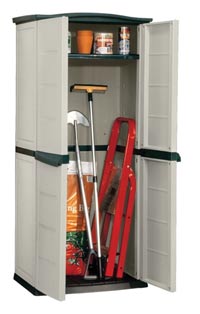 If you decide that your needs are for storage only, your choice of facilities is fairly straightforward – a traditional garden shed. This can be little bigger than a cupboard, to hold a few garden tools and provide room for a couple of chairs. Or it can be big enough to store mowers and cultivators, wheelbarrows and sacks of potatoes. In either case, there is a wide choice of styles, shapes and materials from which to choose. The simplest garden shed consists of a wooden rectangle or square with a floor area of 0,5m² to 1,5m², plus a pent (sloping) roof, door and no windows – although the roof may be of translucent plastic to let in some light. Larger wooden sheds come with either pent or ridge roofs and probably incorporate at least one window. Those with ridge roofs offer more headroom and provide useful storage space for longer items such as beanpoles.
If you decide that your needs are for storage only, your choice of facilities is fairly straightforward – a traditional garden shed. This can be little bigger than a cupboard, to hold a few garden tools and provide room for a couple of chairs. Or it can be big enough to store mowers and cultivators, wheelbarrows and sacks of potatoes. In either case, there is a wide choice of styles, shapes and materials from which to choose. The simplest garden shed consists of a wooden rectangle or square with a floor area of 0,5m² to 1,5m², plus a pent (sloping) roof, door and no windows – although the roof may be of translucent plastic to let in some light. Larger wooden sheds come with either pent or ridge roofs and probably incorporate at least one window. Those with ridge roofs offer more headroom and provide useful storage space for longer items such as beanpoles.
Alternatively, there are Keter sheds – consisting of prefabricated panels that are clicked together to make up a square or rectangular structure, with windows and doors – and easy-to-erect panelled buildings with a simple framework clad with weather-proof panels. Again, there is a wide range of shapes and sizes available to suit your requirements.
Apart from size and style, there are one or two practical points to bearing mind when choosing a storage shed. Firstly, it must have adequate security, as apart from having your costly tools stolen; many house break-ins are committed with the aid of tools taken from unlocked garden sheds. Secondly, it must be totally dry and weatherproof, so that your tools don't rust and the timber doesn't rot. All of which are an integral part of Keter design.
Quite often, it makes sense to combine a garden storage zone with space for a workshop or other activities. For example, the vegetable gardener may also need somewhere to store crops after harvest, such as apples, potatoes and onions for example. A potting shed for spring-time planting activities would also be very useful. The home handyman could combine garden storage with a workshop where he can also store tools and materials. And the family may simply want additional leisure space – an outdoor playroom or sun lounge.
The garden shed
 If you decide that your needs are for storage only, your choice of facilities is fairly straightforward – a traditional garden shed. This can be little bigger than a cupboard, to hold a few garden tools and provide room for a couple of chairs. Or it can be big enough to store mowers and cultivators, wheelbarrows and sacks of potatoes. In either case, there is a wide choice of styles, shapes and materials from which to choose. The simplest garden shed consists of a wooden rectangle or square with a floor area of 0,5m² to 1,5m², plus a pent (sloping) roof, door and no windows – although the roof may be of translucent plastic to let in some light. Larger wooden sheds come with either pent or ridge roofs and probably incorporate at least one window. Those with ridge roofs offer more headroom and provide useful storage space for longer items such as beanpoles.
If you decide that your needs are for storage only, your choice of facilities is fairly straightforward – a traditional garden shed. This can be little bigger than a cupboard, to hold a few garden tools and provide room for a couple of chairs. Or it can be big enough to store mowers and cultivators, wheelbarrows and sacks of potatoes. In either case, there is a wide choice of styles, shapes and materials from which to choose. The simplest garden shed consists of a wooden rectangle or square with a floor area of 0,5m² to 1,5m², plus a pent (sloping) roof, door and no windows – although the roof may be of translucent plastic to let in some light. Larger wooden sheds come with either pent or ridge roofs and probably incorporate at least one window. Those with ridge roofs offer more headroom and provide useful storage space for longer items such as beanpoles.Alternatively, there are Keter sheds – consisting of prefabricated panels that are clicked together to make up a square or rectangular structure, with windows and doors – and easy-to-erect panelled buildings with a simple framework clad with weather-proof panels. Again, there is a wide range of shapes and sizes available to suit your requirements.
Apart from size and style, there are one or two practical points to bearing mind when choosing a storage shed. Firstly, it must have adequate security, as apart from having your costly tools stolen; many house break-ins are committed with the aid of tools taken from unlocked garden sheds. Secondly, it must be totally dry and weatherproof, so that your tools don't rust and the timber doesn't rot. All of which are an integral part of Keter design.
Storage and workroom
If you have decided that you need a workroom as well as a storeroom, then you will want a somewhat larger building. The actual size will, of course, depend on your requirements and the space you have available, but the minimum size you should consider for the purpose is about 1,8m x 3m, with good headroom over the entire floor area. So choose a ridge rather than a bent roof.
One end of the building can then be designated for storage (and will therefore not need a window), while the other end can be used as a potting shed or workshop with a window at waist-level to admit adequate light. This arrangement also ensures that you have plenty of wall space for shelves and other storage arrangements.
Comfort can be important if you are going to work for long periods in the shed. A suspended timber floor will again be an asset here, although you may need to consider ways of setting workbench legs on a concrete screed below the floor level to provide a firm work surface for carpentry and similar jobs. Bear in mind too that a concrete shed will be warmer than a timber one in cold weather, unless the later is lined on the inside.
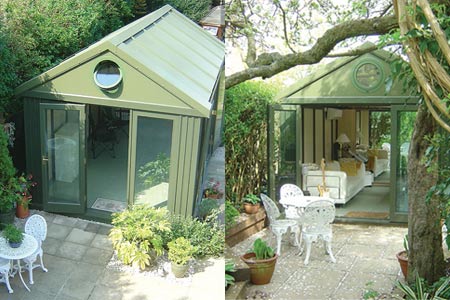
Storage and summerhouse
You may feel that you additional requirements are not so much for space to work in as for space to work in as for space in which to relax – somewhere to sit in a comfortable chair out of the wind on bright, but chilly days. In this case what you need is a summer house, which can also double-up as an outdoor playroom for the children, as well as providing storage space for all your gardening equipment. Do take care however, to place any sharp gardening tools or chemicals safely locked away out of the reach of children's inquiring hands.
There is a choice of timber outbuildings ranging in style from modern to rustic that come in standard sizes, or which can be custom built to suit your individual requirements. Stack-away doors that can be folded away when the weather is hot, are ideal as they really open up the space to the outdoors, yet can be closed when the weather is a little chillier without disrupting the view of your garden.
Finding the right site
Apart from the obvious practical aspects of size and style, it is important to consider the appearance of the building in the garden – whether you want to make it a feature of the garden or disguise it to blend in with its immediate surroundings. Although it is mainly a question of personal taste, it is well worth looking at as many different types and styles as possible and considering all the options before committing yourself to spending money on a building that might look totally out of character with your garden and home once it has been erected.
Timber outbuildings look very attractive when new, however, you must bear in mind that they require regular applications of wood preservative or paint. Concrete buildings on the other hand, need virtually no maintenance and can be made to look exceptionally attractive with the help of simulated or natural stone cladding.
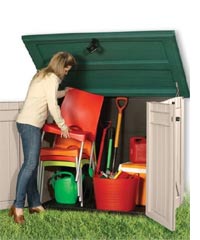 Sheds that are intended purely for storage are best sited where they are most needed. For example, a storage shed for garden tools and equipment might be most practically positioned at the bottom of the garden, while one used mainly for storing garden furniture could go near the back of the house – to one side of the patio or backing on to the garage. A combined storage/workshop will obviously be of most use near the house and a storage/potting shed should be located near to the flower beds or vegetable garden. A summer house on the other hand, should be positioned according to the geography of the garden to catch the maximum sunlight for the longest part of the day.
Sheds that are intended purely for storage are best sited where they are most needed. For example, a storage shed for garden tools and equipment might be most practically positioned at the bottom of the garden, while one used mainly for storing garden furniture could go near the back of the house – to one side of the patio or backing on to the garage. A combined storage/workshop will obviously be of most use near the house and a storage/potting shed should be located near to the flower beds or vegetable garden. A summer house on the other hand, should be positioned according to the geography of the garden to catch the maximum sunlight for the longest part of the day.
It is worth remembering that a building used for any kind of garden storage must be easily accessible, and it might be worth laying a permanent path leading to it, which will be passable in wet, as well as in dry weather. Give some thought too, to whether you will need a supply of electricity to the shed. If it is to be used as a workshop, this will probably be vital for driving power tools and for providing light. Remember that an outbuilding should be supplied via a permanent and separate electrical circuit taken from the house's main distribution board, and that the cables will have to be installed by a professional electrician so as to comply with your home's electrical compliance certificate.
Alternatively, if you don't want to make a feature of your garden shed, it can be tucked away to one side or placed at the bottom of the garden and screened from the house with quick-growing trees, fencing or a screen block wall, or it can be stained or painted to blend with its surrounds, or covered with climbing plants such as ivy.
You may feel that you additional requirements are not so much for space to work in as for space to work in as for space in which to relax – somewhere to sit in a comfortable chair out of the wind on bright, but chilly days. In this case what you need is a summer house, which can also double-up as an outdoor playroom for the children, as well as providing storage space for all your gardening equipment. Do take care however, to place any sharp gardening tools or chemicals safely locked away out of the reach of children's inquiring hands.
There is a choice of timber outbuildings ranging in style from modern to rustic that come in standard sizes, or which can be custom built to suit your individual requirements. Stack-away doors that can be folded away when the weather is hot, are ideal as they really open up the space to the outdoors, yet can be closed when the weather is a little chillier without disrupting the view of your garden.
Finding the right site
Apart from the obvious practical aspects of size and style, it is important to consider the appearance of the building in the garden – whether you want to make it a feature of the garden or disguise it to blend in with its immediate surroundings. Although it is mainly a question of personal taste, it is well worth looking at as many different types and styles as possible and considering all the options before committing yourself to spending money on a building that might look totally out of character with your garden and home once it has been erected.
Timber outbuildings look very attractive when new, however, you must bear in mind that they require regular applications of wood preservative or paint. Concrete buildings on the other hand, need virtually no maintenance and can be made to look exceptionally attractive with the help of simulated or natural stone cladding.
 Sheds that are intended purely for storage are best sited where they are most needed. For example, a storage shed for garden tools and equipment might be most practically positioned at the bottom of the garden, while one used mainly for storing garden furniture could go near the back of the house – to one side of the patio or backing on to the garage. A combined storage/workshop will obviously be of most use near the house and a storage/potting shed should be located near to the flower beds or vegetable garden. A summer house on the other hand, should be positioned according to the geography of the garden to catch the maximum sunlight for the longest part of the day.
Sheds that are intended purely for storage are best sited where they are most needed. For example, a storage shed for garden tools and equipment might be most practically positioned at the bottom of the garden, while one used mainly for storing garden furniture could go near the back of the house – to one side of the patio or backing on to the garage. A combined storage/workshop will obviously be of most use near the house and a storage/potting shed should be located near to the flower beds or vegetable garden. A summer house on the other hand, should be positioned according to the geography of the garden to catch the maximum sunlight for the longest part of the day.It is worth remembering that a building used for any kind of garden storage must be easily accessible, and it might be worth laying a permanent path leading to it, which will be passable in wet, as well as in dry weather. Give some thought too, to whether you will need a supply of electricity to the shed. If it is to be used as a workshop, this will probably be vital for driving power tools and for providing light. Remember that an outbuilding should be supplied via a permanent and separate electrical circuit taken from the house's main distribution board, and that the cables will have to be installed by a professional electrician so as to comply with your home's electrical compliance certificate.
Alternatively, if you don't want to make a feature of your garden shed, it can be tucked away to one side or placed at the bottom of the garden and screened from the house with quick-growing trees, fencing or a screen block wall, or it can be stained or painted to blend with its surrounds, or covered with climbing plants such as ivy.

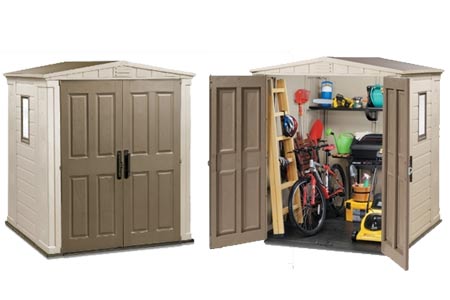
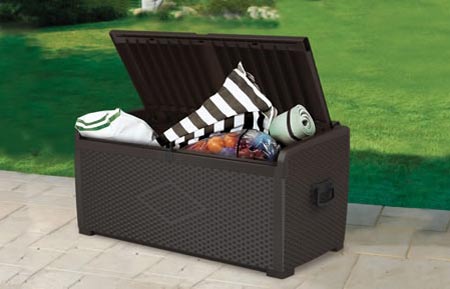





0 comments:
Post a Comment